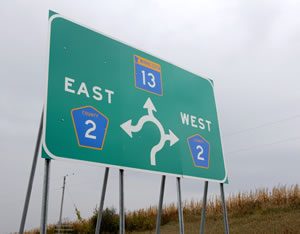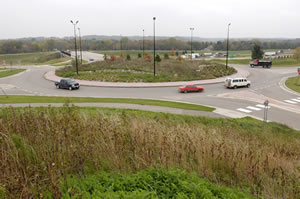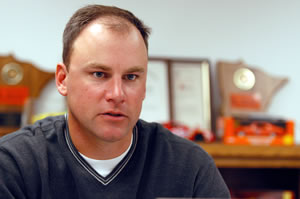 |
|
This sign on Hwy 13 and Scott County Road 2 gives motorists a graphic notice as they approach the new roundabout. Photo by David Gonzalez |
Whether he’s heading west to go fishing or east with a truckload of apples to market, grower Denny Havlicek turns the same way at the first intersection he encounters—right.
That’s because the intersection of Hwy 13 and Scott County Road 2, a few miles from his orchard near New Prague, is a roundabout.
Roundabouts replace standard highway intersections controlled by stop signs or traffic lights. They create a one-way, circular path around an intersection where traffic flows in a counter-clockwise direction.
Drivers merge into the one-lane path at reduced speeds, turning off when they reach their exit.
Ken Johnson, a Metro District design project engineer, said a roundabout design was chosen for the rural Hwy 13/County Road 2 intersection due to its high rate of serious injury crashes. During the past five years, he said, crashes resulted in two deaths and 50 serious injuries.
Johnson said roundabouts eliminate potential traffic conflicts that can result in crashes in a standard intersection. A typical intersection has 32 conflict points, 16 of which are crossing conflicts. The crossing conflicts lead to the most dangerous crashes: right-angle or left-turning collisions.
 |
Motorists move around one of the roundabouts that connect I-35 with Steele County Road 12 in Medford. Landscaping improves safety on the roundabouts by helping drivers stay focused on the roadway. Photo by David Gonzalez |
A roundabout, however, has only four merging conflict points. If a crash occurs with a merging conflict, it typically leads only to a fender bender, he said.
Since the roundabout opened in early September, there have been no crashes. It handles about 7,000 vehicles per day.
The Hwy 12/County Road 2 site is the second interchange using the roundabout design built by Mn/DOT. The first, which actually includes two roundabouts, was completed in 2002 near Medford. The twin roundabouts provide access via a county road from Interstate 35 to an outlet mall and other stores near the freeway.
Chances are good, highway designers say, that there will be more.
Jim Roberts, resident engineer at Rochester/District 6’s resident office at Owatonna, said the twin roundabouts have worked well and earned support from business owners, city officials and motorists.
Johnson said roundabouts, prevalent in Europe and on the East Coast, are gaining support quickly in other parts of the United States.
Wisconsin, for example, has constructed 12 roundabouts and plans to build 60 more, he said.
 |
Jim Roberts, resident engineer at Owatonna, directed construction of the twin roundabouts adjacent to I-35 in Medford. Photo by David Gonzalez |
Several Minnesota cities now use roundabouts including Minneapolis, Stillwater, Maplewood and Chaska.
Mankato/District 7 plans to use a pair of roundabouts to connect Steele County Road 7 and Hwy 14 when it rebuilds the highway between Waseca and Owatonna.
Peter Harff, a District 7 design project engineer, said using roundabouts will allow the use of a narrower, less expensive bridge design.
“By using roundabouts,” Harff said, “we can eliminate traffic signals and build a lower-cost structure because we won’t need to have separate turn lanes on the bridge.”
At his booth at the Midtown Farmers’ Market in Minneapolis, Havlicek said the new roundabout makes his frequent travels easier and safer.
“I first encountered them on a trip to the Netherlands,” he said. “It’s a very smart thing to do—and you’re a lot less likely to get hit than in an intersection.”
By Craig Wilkins
|



